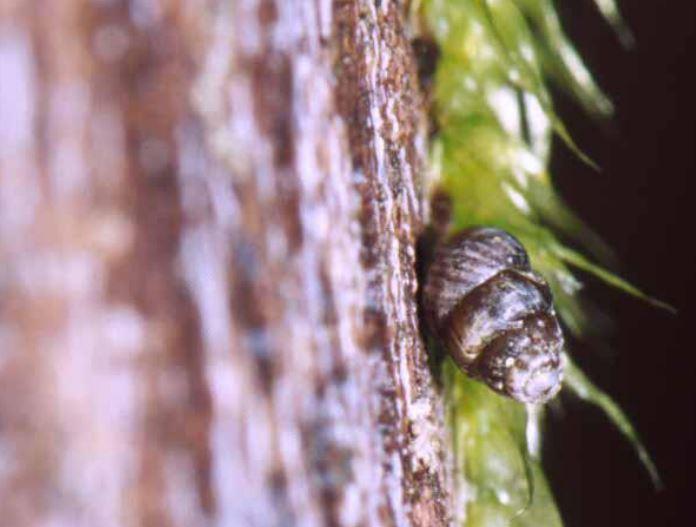Low-
Moderate
The population size of Idaho vertigo is critical and the trend is unknown. These small snails are very rare and found in small, isolated populations, perhaps remnants of a previously much wider range. These small populations are very vulnerable to logging, road building, fires, or other disturbances. The typical habitat for Vertigo snails ranges from moist riparian to relatively dry forests dominated by cottonwood, alder, Douglas-fir, spruce, or hemlock, depending on the species.
Description and Range
Physical description
he Vertiginidae family of terrestrial snails are minute (roughly .05 to 0.12 inch) with ovoid-shaped shells.
Ecology and life history
This species is a riparian associate, but there is little other information. Habitat characteristics are described from only the type locality. At this site, the Idaho vertigo inhabits a mid-elevation grass and sedge meadow with springs, seeps, bogs, and fens.
Land snails, including Vertiginid snails, are hermaphroditic and exchange gametes with conspecific individuals when conditions are favorable. At least some species seem to retain the fertilized eggs and give birth to small numbers of live young.
The Hoko vertigo is thought to be a short-lived species with a potential life span of less than two years.
The distinctly arboreal lifestyle and mouthparts of this group of snails suggest that they feed on microorganisms growing on the surfaces of smooth-barked trees and shrubs or epiphytic lichens.
In Pacific Northwest forests, Vertiginidae snails overwinter on tree limbs, so presumably they are not killed by freezing temperatures.
Geographic range
Burke (2013) collected this species along a creek in Stevens County, Washington. Pilsbry (1948) found it along a creek east and northeast of the old town, Meadows, Adams County, Idaho. The type locality is the only known Idaho site, but this population has not been relocated. Searches during 1988, 1993, and 1994 within the lower Salmon River, Little Salmon River, and Payette River drainages in Idaho have also failed to find this species.
Climate vulnerability
Sensitivity to climate change
Low
There is limited information on the sensitivity of this species to climate change. It is found in a mid-elevation grass and sedge meadow with springs, seeps, bogs, and fens. Activities or events that alter conditions, such as moisture levels and temperature, may make this species vulnerable.
Exposure to climate change
Moderate
- Increased temperatures
- Reduced soil moisture and/or drought
- Altered fire regimes
Conservation
Conservation Threat and Actions Needed
- Resource information collection needs
- Threat: Lack of species distribution data.
- Action Needed: Conduct an inventory and status assessment of this species.
See the Climate vulnerability section for information about the threats posed by climate change to this species.
Resources
References
Duncan, N. 2005. Conservation Assessment for Vertigo n. sp., Hoko Vertigo. Originally issued as Management Recommendations by John S. Applegarth, February 1999. Revised by Nancy Duncan, October 2005. USDA Forest Service Region 6 and USDI Bureau of Land Management, Oregon and Washington, 16 pp.
Burke, T. E. 2013. Land Snails and Slugs of the Pacific Northwest. Oregon State University Press, Corvallis, OR. 344 pp.
Frest, T. J. 1999. A Review of the land and freshwater Mollusks of Idaho. Final report to the Idaho Conservation Data Center, Idaho Department of Fish and Game, 600 South Walnut, P.O. Box 25, Boise, Idaho 83707. 281 pp. plus appendices.
Jordan, S. 2013. Vertigo andrusiana (Pilsbry 1899) Pacific Vertigo. Species Fact Sheet. Xerces Society. Prepared for the Interagency Special Status/Sensitive Species Program, Forest Service, Bureau of Land Management.
NatureServe. 2014. NatureServe Explorer: An online encyclopedia of life [web application]. Version 7.1. NatureServe, Arlington, Virginia. Available http://explorer.natureserve.org. (Accessed September 11, 2014 ).
Pilsbry, H. A. 1948. Land Mollusca of North America (north of Mexico). Monograph of the Academy of Natural Sciences of Philadelphia, 2(2): 521-1113.
USFWS. 2011. Endangered and Threatened Wildlife and Plants: 90-day finding on a petition to list 29 mollusk species as threatened or endangered with critical habitat: proposed rule. Federal Register 76 (No. 193, October 5, 2011): 61826-61853.
